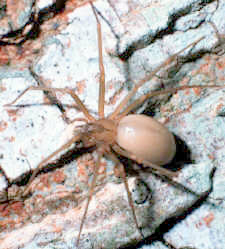 The best-known of the recluse spiders inhabits many of the Southern and Midwestern states.They are often found in garages, firewood piles, cluttered cellars, and piles of stored boards. Around homes they are often found around bathrooms, bedrooms and closets, under furniture, behind baseboards and door facings, or in corners and crevices. They are most active during the night when they hunt. People are often bitten while they are asleep after rolling over one in bed. Others are bitten while putting on clothes that have been hung undisturbed near where they are hiding for some time.
The best-known of the recluse spiders inhabits many of the Southern and Midwestern states.They are often found in garages, firewood piles, cluttered cellars, and piles of stored boards. Around homes they are often found around bathrooms, bedrooms and closets, under furniture, behind baseboards and door facings, or in corners and crevices. They are most active during the night when they hunt. People are often bitten while they are asleep after rolling over one in bed. Others are bitten while putting on clothes that have been hung undisturbed near where they are hiding for some time.
Recluse spiders as their name implies are generally shy. They spin nondescript white or grayish webs, where they may hide during the day. They are predators of insects and other arthropods. Brown recluse spiders lay 1-2 egg masses per year in dark, sheltered areas. The egg cases are round, about 5/8 inch (1.6 cm) in diameter, flat on the bottom and convex on top. After 24 to 36 days the spiderlings emerge from the egg case. Their slow development is influenced by their nutrition and environmental conditions.
Characteristics
- Irregularly shaped white or grayish webs
- When walking, body and legs cover the area of a quarter or half-dollar
- Body is only ¼ to ½ inch long
- Coloration varies from orange-yellow to dark brown
- Have 6 eyes arranged in three pairs in a semicircle on the forepart of the head.
- Contains a violin-shaped marking on the back.
Bite Symptoms
The effects of a recluse bite can be felt immediately or delayed, depending on the amount of venom injected and the victim’s sensitivity.At first the bite might be hardly noticed, but later cause a stinging sensation or intense pain. Fever, chills, nausea, weakness, restlessness and/or joint pain occur within 24-36 hours. The bite may produce a small blister surrounded by a large, congested, swollen area. The venom usually kills the affected tissue which gradually sloughs away and exposes underlying tissues. The edges of the wound thicken, while the exposed center fills with dense scar tissue. Healing can take between 6-8 weeks and leave a scar, depending on the amount of venom injected and the reaction of the individual.